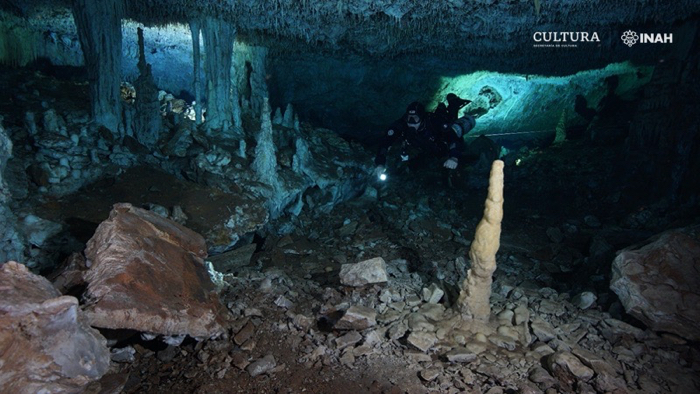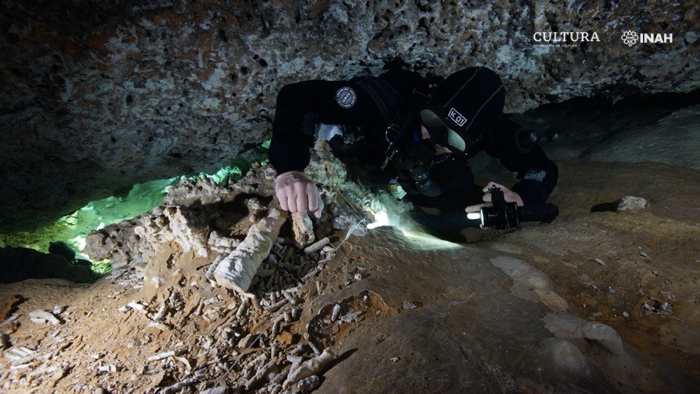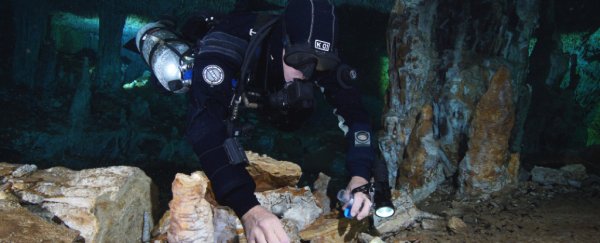The underwater caves along Mexico's Yucatán Peninsula contain within them a sprawling labyrinth of archaeological relics perhaps unlike anywhere else on Earth.
Preserved in a vast network of flooded caverns, these inundated cenotes hold a treasure trove of Maya secrets – but as a new discovery shows, you can also find ancient artefacts dating back to much more distant episodes of prehistory.
In a new study, researchers report the finding of what could be the oldest known mine in the Americas (alongside other claims to the title), uncovering the remains of a subterranean ochre mine dating back to 12,000 years ago.
"The underwater caves are like a time capsule," says expert diver and micropalaeontologist Ed Reinhardt from McMaster University in Canada.
"There is clear evidence of ochre mining which would have taken place thousands of years ago."
 (Sam Meacham/CINDAQ. A.C. SAS-INAH)
(Sam Meacham/CINDAQ. A.C. SAS-INAH)
In dives during 2017, Reinhardt and fellow researchers explored caves along the eastern coastline of Quintana Roo. Caves in this region have long been known to contain the skeletal remains of ancient peoples who inhabited the caverns thousands of years ago, back when lower sea levels meant the caves were dry and accessible.
As to why ancient individuals would enter these deep and dangerous labyrinthine passages has remained unclear, but now we appear to have an explanation.
"The cave's landscape has been noticeably altered, which leads us to believe that prehistoric humans extracted tonnes of ochre from it, maybe having to light fire pits to illuminate the space," says diver and archaeologist Fred Devos from the Research Centre of the Quintana Roo Aquifer System (CINDAQ) in Mexico.
Inside the caves, the team found a range of evidence of prehistoric mining activities, including digging tools, ochre extraction beds, navigational markers, and ancient fireplaces.
The researchers suggest mining evidence in three submerged cave systems spans about 2,000 years of operation – from 12,000 to 10,000 years ago.
The sites, called La Mina, Camilo Mina, and Monkey Dust, may be the oldest known examples of ochre mining in the Americas, but the team thinks cave exploration and ochre mining in the region may date back even further, based on other skeletal evidence dated to 12,800 years ago.
For some reason, the miners in this site stopped their ochre extraction about 10,000 years ago. As to why, the researchers are unsure, as the cave would still have been accessible at that point. It's possible, they say, that the miners moved on to other deposits in other caves – and with 2,000 kilometres of known cave systems to explore in the region, we might find more evidence of this ancient mining in the future.
What is certain is that it must have taken unimaginable bravery to delve for hundreds of metres into these jagged caves, with only a lit torch to shine a path in the buried darkness.
 (Sam Meacham/CINDAQ. A.C. SAS-INAH)
(Sam Meacham/CINDAQ. A.C. SAS-INAH)
That they ventured into the dark like this in such conditions tells us something about how important the ochre pigment must have been in ancient Palaeoindian rituals and customs, that they were willing to risk their lives for their prize.
"Imagine a flickering light, in the middle of deep darkness," says team member James Chatters from Applied Paleoscience in Washington State, "that at once illuminates the red-stained hands of the miners as they strike the ground with hammers made out of stalagmites, while it lights the way for those who carry the ochre through the tunnels until they reach sunlight and the forest floor."
The findings are reported in Science Advances.
